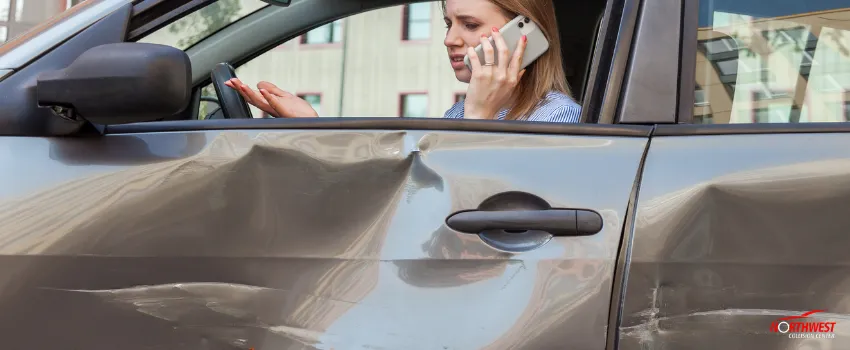When it comes to auto body repair, several techniques are available to restore your car’s original appearance and design. Each technique serves a specific purpose and is suitable for different types of damage.
Understanding the different auto body repair techniques is essential for determining which method is best suited for your car. These can range from traditional methods like dent repair and painting to more advanced approaches like paintless dent removal and body panel replacement.
Common Auto Body Damage
Before finding out how to do body work on a car, you should become familiar with the types of body damage that most autos can suffer from. These include the following:
1. Scratches
These are surface-level marks that occur when the paint is scraped or rubbed off. They can range from minor superficial scratches to deep gouges.
2. Dents
These are depressions or deformations in the vehicle’s body caused by impact. Dents can vary in size and severity, from small dings to larger creases.
3. Cracks
These are often linear fractures in the glass or plastic components of a car, such as windshields or headlights. Cracks can impair visibility and compromise a vehicle’s structural integrity.
4. Hail Damage
These are dents or dings resulting from falling hailstones. Hail damage often leads to numerous small dents running across a car’s surface.
5. Paint Damage
This can cover chipping, fading, peeling, or blistering of auto paint. It usually occurs due to age, exposure to harsh weather, or improper maintenance.
6. Frame Damage
This involves structural damage to a vehicle’s frame or chassis, typically resulting from a major road accident. Frame damage can affect the overall safety and performance of any automobile.
What is the most common type of auto repair?
One of the most common types of car body damage repair is related to the electrical system of an auto. Modern vehicles are equipped with complex electrical systems that control various components, including the ignition, lights, power windows, and infotainment systems.
Issues with the electrical system can result in a range of problems, such as a dead battery, malfunctioning lights, or non-responsive electronics. Obviously, electrical repairs are required in these cases.
Major and Minor Damage
Major damage refers to significant or extensive harm or destruction inflicted upon an object or property. It can have a significant impact on the functionality, structural integrity, or overall value of the affected entity. For example, in a car accident, major damage might include extensive structural deformations, engine failure, or irreparable damage to critical components.
Minor damage is relatively minor or superficial. It generally indicates that the damage is less severe or easily repairable. Minor damage may not significantly impact the functionality or structural integrity of the affected entity, and it can often be fixed with simple repairs or maintenance.
5 Common Auto Body Repair Techniques
The best body repair technique for your car depends on the extent and nature of the damage it has sustained. Here are the common repair methods and when they are most suitable.
1. Paintless Dent Repair
Also known as PDR, this is a technique used to repair small dents where the paint has not been damaged. Skilled technicians use specialized tools to carefully massage the dent out from the inside of the panel.
2. Traditional Dent Repair
When the dent is large, has damaged a vehicle’s paint, or cannot be accessed from behind, the traditional auto body repair process is often considered. This can involve filling the dent with body filler, reshaping the damaged area, and repainting the affected panel.
3. Frame Straightening
In accidents with significant impact, the vehicle’s frame or chassis may become bent or twisted. Frame straightening is often used in this case as it involves specialized equipment to restore the vehicle’s structural integrity.
4. Paint Matching and Refinishing
When a panel has significant damage or requires extensive repairs, it may be necessary to repaint the affected area. Skilled painters use color-matching and other advanced auto painting techniques to ensure that the new paint matches the existing color of the vehicle seamlessly.
5. Panel Replacement
In cases where a car panel is too damaged to be repaired effectively, the best option is to replace it entirely. Expert technicians carefully remove the damaged panel and install a new one. Proper alignment, fitting, and color matching are essential to achieve a seamless and factory-like finish.
Key Takeaway
The success of different auto body repair techniques depends on factors like the expertise of the car technician, the equipment that will be used, and the specific requirements of your car. Consulting with a reputable auto body repair shop is recommended so the damage can be assessed properly and the best technique can be determined.
Auto body damage needs to be addressed promptly to prevent further deterioration and maintain the vehicle’s value and safety. This will naturally entail costs, but this will still depend on the specific type and severity of the damage.
Settle for the best auto body repair service from Northwest Collision Center.
If you’re trying to find out how to fix car body damage, you need not really look far. When it comes to auto body repair, nothing comes close to Northwest Collision Center.
Our auto body repair Largo, FL, team is composed of professional and certified car technicians who use the most advanced repair equipment. Rest assured that you’ll have your damaged car looking new again. Call us today.
















